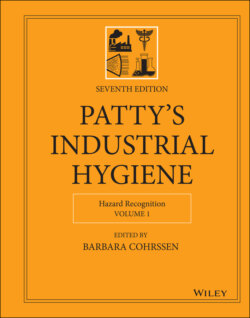Читать книгу Patty's Industrial Hygiene, Hazard Recognition - Группа авторов - Страница 119
4.4 Multidisciplinary Control Banding
ОглавлениеRecent CB expansion of range, beyond bulk chemicals for IHs and into other EHS professions, uses the basic stratification of practical prevention strategies as earlier risk matrices. This includes barrier banding, a strategy utilizing CB concepts for OS rather than IH (28). Barrier banding explores the practicality of addressing safety accident scenarios, implementing barriers, and managing solutions in a simplified manner to achieve injury reduction (11). This approach to takes classification of safety hazards and seeks to offer barrier controls to achieve risk reduction based on accident scenario determinants. Benefits are seen at the SME level where banding strategies in safety present an opportunity to reduce accidents. A tool that can lead decision‐makers to make a priori determinations for the proper hazard‐based safety controls to protect workers is valuable for accident prevention. CB in ergonomics offers comparable approaches for controlling musculoskeletal disorders within worker‐based programs (14, 29).
The use of a qualitative, risk‐based CB strategy for assessment and control of potential environmental contaminants also provides a standardized approach to improve risk communication. The CB model used by EAs is also designed for integration within an OHSMS program to provide the basis for a holistic approach for EHS professionals. The simplified environmental risk matrix is also stratified over four RLs. Examples of qualitative environmental CB strategies have been applied to comply with United States regulations for construction, research activities, facility maintenance, and spill remediation that affect air, water, soil, and waste disposal. These CB risk matrix models collectively provide the basis for a standardized risk communication language that is well positioned to improve communications within and between EHS professionals, workers, and management (30). A somewhat surprising by‐product of the expanding use of CB internationally is that it has been an extremely helpful tool for risk communication not only within the workplace as designed but also within and between EHS professionals (31). The discussion of CB principles and strategies has become an effective means for teaching how IH practitioners think when performing risk assessments and has also played an important role in the growth of the profession in places in the world where it is most needed. Once this risk communication potential was realized, the development and dissemination of CB and related banding strategies began harnessing this important component of risk management and began the process of simplifying risk assessment and control continued across the EHS professions and into EORM.
